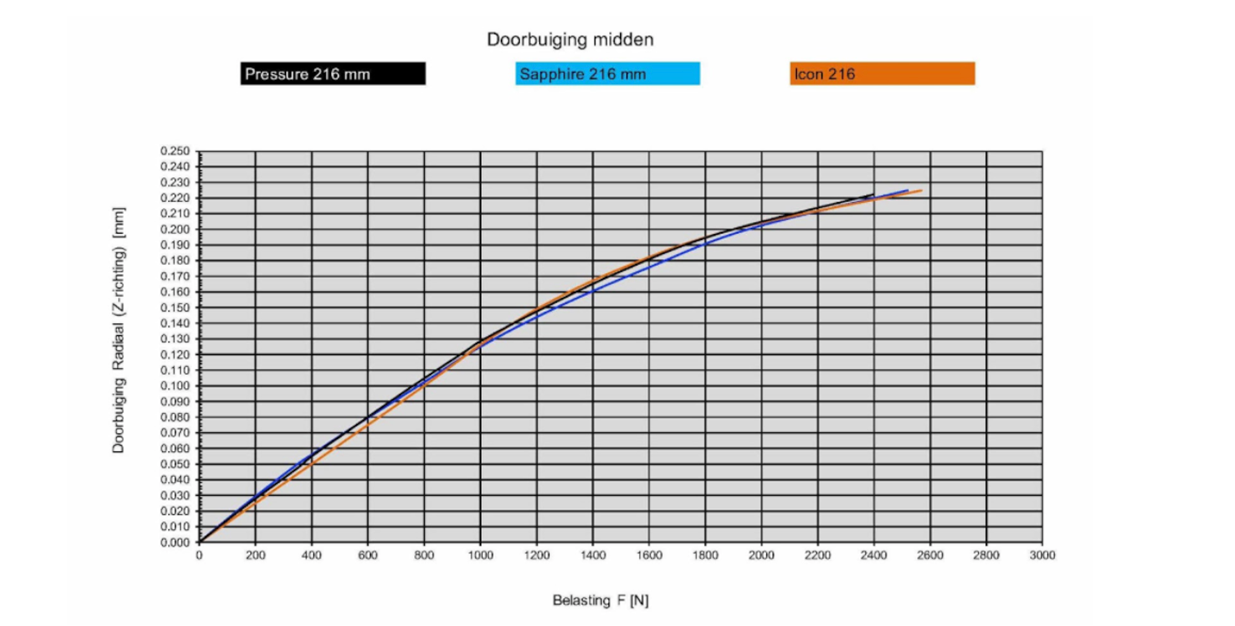"Measuring means knowing" is a Dutch saying, but of course to collect useful data you have to work extremely accurately. In order to get a clear measurement result, Hans has ensured steady conditions for the comparison between the blades. This takes a lot of effort.
To measure everything correctly, the skates need to be prepared in the exact same way:
- The rocker is exactly 23 meters
- The height of the profile is exactly 40.2 millimeters
- The distance between the pivot point and the heel rest is identical
- The blades are straight
In order to measure the blade correctly, two different types of forces are measured. In order to do so the force on the skate is divided into two components. The direction "perpendicular" to the blade and "in the plane" of the blade. When the force is directed perpendicular to the blade, we call it the lateral or axial direction. If the force is in the height direction of the blade, we call this the normal or radial direction.

Rocker of the skate
This radial force changes the rocker while skating. Read more about it in this blog. The radial force causes the skate to bend to the side and therefore allow more or less "pressure" into the ice. Both forces influence the steering behaviour of the skate. You can read below how this affects the test results.
Height of the skate
But first of all, the height of the blade. This has a major influence on the behavior of the skate and therefore the feeling. The higher the blade, the more pressure the skater experiences. This also makes the skate less "forgiving" in its steering behaviour. A high blade also ensures that the rocker is less flat.
If you make the blade lower, the skate becomes stiffer in the lateral direction, the rocker folds less to the side. As a result, the skate tends to go straighter, so you can skate a little easier, with less forced pressure. This is desirable for longer distances, in order to achieve that the skaters legs do not 'fill up' so quickly, in other words that your muscles do not acidify as quickly.
If you are changing the height of a blade, this will have a major influence on the outcome of the test. It is therefore essential for a good comparison that the height of the blade is exactly the same.
Size of the bridge
In addition, the size of the bridge is very important. If the distance between the pivot point and the wedge or ridge is big, the skate will behave more flexible than if its small. A more flexible skate will generate more pressure and the same applies to the opposite. As a result, skaters with a large shoe size by definition skate on more flexible skates and therefore skate with more pressure, the blade moves more to the side and the rocker decreases, while skaters with a small shoe size skate on relatively stiff skates with less pressure. This effect can be compensated by adjusting the height of the blade and the rocker. So a lower blade with a smaller radius for heavier skaters with bigger feet will give less sideway movement while compensating for the loss of rocker, or a higher blade with a bigger radius for lighter skaters with smaller feet.
Force measured in radial direction, in which change of the rocker occurs. See this blog for more information.
Sapphire, Icon and Pressure almost identical
If we prepare the Icon and Sapphire of Viking and the Pressure in the exact same way according to the above principles, the skates turn out to behave almost identical, as can be seen in the graphs below:

Force measured in lateral, or axial direction. The skate bends and allows more or less "pressure" into the ice.
 Force measured in radial direction, in which change of the rocker occurs. See this blog for more information.
Force measured in radial direction, in which change of the rocker occurs. See this blog for more information.
The skates are measured in radial (height) direction and lateral or axial direction with an increasing load of 100N to 700N axially and up to 2500N radially. The skates are measured at different points on the blade. When the pressure on the ice is applied at the beginning of the sliding phase; to the end of the push, when the maximum pressure is at the pivot point.
It is noticeable that the Pressure bends slightly more in the middle at low load while the icon is slightly stiffer there. The differences are still almost unnoticeable. As the load increases towards the pivot point, all skates behave identically.
Closing thoughts
The measurement determines the stiffness (elasticity) of the blades, the occurring deformation is restored, and the feeling this translates to on the ice. Of course, these are not the only factors that determine the quality of a skate.
The skates are very similar but there are also notable differences, for example, the tensile strength of the Pressure blade is many times higher. You will notice this immediately if you try to bend the Cádomotus blades, you will have to push much further to permanently deform the skate. In other words, the Pressure will better keep its shape (read: stay straight). Another detail is that the Pressure has larger bearings that can withstand a greater load and therefore last longer.

 Triathlon
Triathlon
 Outlet!
Outlet!
 CádoWiki
CádoWiki
 About Us
About Us









